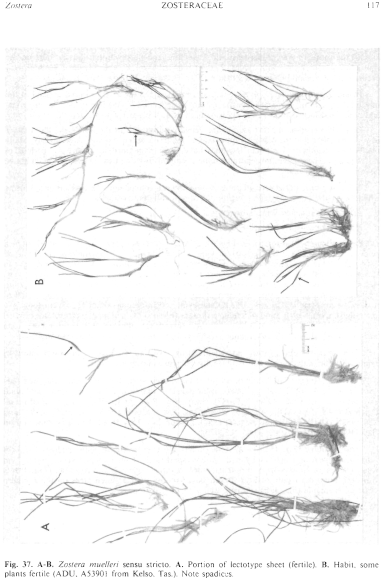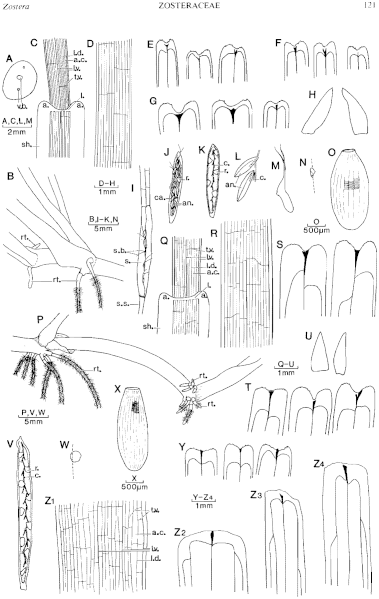|
|
|
|
|
|||||||||||
|
Electronic Flora of South Australia Species Fact Sheet
Phylum Magnoliophyta – Subphylum Seagrasses – Class Liliopsida – Subclass Alismatidae – Order Potamogetonales – Family Zosteraceae
Selected citations: Aston 1973: 322, figs 136c,d, 137a, 138. den Hartog 1970: 87, figs 24, 25. Jacobs & Williams 1980: 454. Jessop 1978: 73. Sainty & Jacobs 1981: 427. Setchell 1933: 815. Willis 1970: 67.
Rhizomes 1–2 (–3) mm in diameter, internodes 2–3 (–5) cm long, in transverse section (Fig. 39A) showing only 2 vascular bundles in the outer cortex, one either side of the central strand, one leaf and 2 only, or 2–6 (–10) roots in each of two groups per node. Vegetative shoots short, usually 1–2 cm long. Leaves 2–4 (–5) per shoot; sheath usually about 5 cm long (up to 20 cm long in permanently submerged plants of the robust estuarine form), ligule about 0.1 mm long, auricles to 0.5 mm long; blade linear, usually 5–10 cm long (to 60 cm long when plants permanently submerged, e.g. in Onkaparinga R. estuary, S. Aust.), 1–2 (–3) mm broad, longitudinal veins 3, the 2 lateral ones very close to the margin so that the leaf may appear 1-veined to the naked eye, longitudinal air canals 5–8 on each side of the midvein; apex rounded with a shallow or deep notch and frequently small denticulations. Fertile shoots short and bearing a single spadix (or a succession of single spadices), or 15–30 cm long (up to 60 cm in some estuarine material) and branched sympodially, bearing many spadices; spadix subsessile. Male and female flowers 4–12 of each per spadix; retinacules broadly triangular to suborbicular, (0.5–) 1.3- .5 (–1.7) mm broad, L/B 0.7–1.4. Seed ellipsoid, 2.2–2.4 mm long, testa yellow-brown or brown, shiny, with 16–20 longitudinal striations and numerous finer transverse striations.
Lectotype from "Australia felix" (F. Mueller, Nov. 1852); in MEL, 3759.
In November 1852, Mueller made many collections in the Port Phillip area including near the mouth of the River Yarra, which was part of "Australia felix" (see p. 78), It is this region that is assumed to be the type locality of Z. muelleri.
Selected specimens: The lectotype and Port Gawler, S. Aust., low eulittoral, tidal mud flats (Robertson, 6.xii.1981; ADU, A52804). Swan Bay, Port Phillip Bay, Vic., uppermost sublittoral (Womersley, 13.v.1982; ADU, A53087). Swan Bay, Port Phillip Bay, Vic., low eulittoral (Shepherd, 4.v.1980; ADU, A51059). Kelso, Tas., low eulittoral (H. Robertson, 5.xii.1982 and 23.i.1983; ADU, A53901 and A54000 resp.). Lagoon Bay, Low Head, Tas., low eulittoral on flats (Womersley, 6.xi.1982; ADU, A53970). Port Gawler, S. Aust., 0.5 m deep in pools on tidal mud flats (Robertson, 16.xii.1981; ADU, A52802). Onkaparinga R. estuary, S. Aust., 0.25 m deep at edge of channel (Thomas, 11.xii.1975; ADU, A46712). Onkaparinga R. estuary, S. Aust., 0.5 m deep (Robertson, 13.x.1981; ADU, A52695). Onkparinga R. estuary, S. Aust., lowest eulittoral (Robertson, 10.xii.1981; ADU, A52783). Camp Noonameena, N. Lagoon, Coorong, S. Aust., drift (Robertson, 18.ix.1982; ADU, A53633). Mallacoota, Vic., in lagoon isolated by sandbar (Womersley, 12.xi.1982; ADU, A53978). Twofold Bay, N.S.W., in sand over mud in inlet open to bay (Jacobs 2410 and 'Williams, 18.xi.1975; ADU, A52009). Wallagoot Lake, N.S.W., submerged lake margin (Jacobs 2421 & Williams, 18.xi.1975; ADU, A52007).
Distribution: From Goldsmith Beach (near Edithburgh), Yorke Peninsula, S. Aust., eastwards around the southern Australian coast and Tasmania, and northwards to Sussex Inlet on the southern coast of New South Wales. Zostera muelleri (syn. Z. novazelandica Setchell) also occurs in New Zealand (Moore & Edgar 1970, p. 9; Moore & Irwin 1978, p. 202–3).
Taxonomic notes: In southern Australia Z. muelleri is found in inlets and estuaries, on mud or sand in the intertidal region on calm water coasts, in lagoons separated by sandbars from the open sea, and other land-locked waters only occasionally in direct contact with the sea.
Characters such as the leaf apex shape, length and breadth of the leaf blade, the number of roots per node and the degree of branching of the fertile shoot can vary considerably. Many plants from southern Australian localities have been maintained in culture for periods of 2–12 months. These have flowered and some produced fruits and the characters given above have remained constant.
The range of material recognised as Z. muelleri can conveniently be divided into 2 forms which cover the same geographic region but occupy different ecological niches.
(a) Zostera muelleri sensu stricto (i.e. in a narrow, or strict sense)
(b) Zostera muelleri estuarine form.
(a) Zostera muelleri sensu stricto (Figs 37, 39A-0). Roots (Fig. 39B) usually only 2 at each node. Leaf blade (Fig. 39C,D) 5–10 cm long, 1–2 mm broad, 5–7 longitudinal air canals on each side of the midvein, transverse veins regular, usually continuous from the midvein to the submarginal vein, submarginal veins reaching almost to the notched leaf apex (Fig. 39E–G) before uniting with the midvein. Squamules (Fig. 39H) lanceolate. Fertile shoots short, bearing 1-few spadices (often only one apparent at a time), spathes (Fig. 391) on flattened stalks 2–4 cm long, spadix (Fig. 39J,K) subsessile, linear-oblong, about 1 (–1.5) cm long, 4–6 male flowers (Fig. 39J,L) and 4–6 female flowers (Fig. 39J,M) per spadix; retinacules (Fig. 39J,K,N) 1.3–1.7 mm broad, L/B 0.7–1.4. Seed (Fig. 390) ellipsoid, 2.0–2.1 mm long, testa brown, shiny, with 16–18 longitudinal striations and numerous finer transverse striations.
This form is found in inlets and sheltered bays, on sand or mud in the lower intertidal region on calm-water coasts and is normally emergent during low tide.
The lectotype (Fig. 37A) of Z. muelleri has short fertile shoots with spadices 1–1.3 cm long and appearing singly and not in groups, spathes short on flattened stalks about 2 cm long. The leaves are narrow with notched apices and there are only two roots per node. Plants from the intertidal region of Port Phillip Bay, Victoria and sheltered areas on the northern coast of Tasmania (Fig. 37B) compare well with the lectotype.
(b) Zostera muelleri estuarine form (Figs 38A,B, 39P–X). Roots (Fig. 39P) arising in two distinct groups of 2–6 (–10) at each node. Leaf blade (Fig. 39Q,R) 10–20 (–60) cm long, (1.5–) 2–2.5 (–3) mm broad; 6–8 longitudinal air canals on each side of the midvein, transverse veins somewhat irregular, rarely continuing unbroken from the midvein to the submarginal vein, submarginal veins uniting with the midvein some distance from the notched leaf apex (Fig. 39S,T). Squamules (Fig. 39U) lanceolate. Fertile shoots (Fig. 38A,B) elongate, branched sympodially, bearing several spadices; spathe linear, stalked; spadix (Fig. 39V) linear, about 2.5 (–3) cm long, subsessile; 6–10 (–12) male flowers and 6–10 (–12) female flowers per spadix; retinacules (Fig. 39V,W) 0.5–1 mm broad, L/B 0.7–1.2. Seed (Fig. 39X) narrowly ellipsoid, 2.0–2.4 mm long, testa yellow-brown, shiny with 18–20 longitudinal striations and numerous finer transverse striations.
This form is usually just subtidal and rarely if ever emergent, frequently in estuarine localities, on the edge of channels or in lagoons and other land-locked waters which are only rarely in contact with the open sea.
Numerous intergrades [e.g. Port Gawler, S. Aust., mid eulittoral with mangroves (Robertson, 16.xii.1981; ADU, A52800) (see Fig. 39Y)] occur between Z. muelleri sensu stricto and the robust estuarine form and all of these are here referred to Z. muelleri sensu lato. The central mucro characteristic of Z. mucronata is also a very variable character and numerous intergrades occur between both forms of Z. muelleri and Z. mucronata. If the character of roots arising in two groups at the node is a Z. capricorni character (den Hartog 1970, pp. 64, 81), then many southern Australian populations may be intergrades between Z. capricorni and eitherZ. muelleri or Z. mucronata.
Between the eastern limit of Z. mucronata and the south-western limit of Z. capricorni, Z. muelleri with all its variations is the generally recognised species, and its range overlaps with Z. mucronata to the west and Z. capricorni to the east. However, within the range of Z. muelleri on the South Australian and Victorian coasts a broad spectrum of intergrades occurs and further work is required to elucidate the Z. mucronata-Z. muelleri-Z. capricorni complex.
References:
ASCHERSON, P. (1867a). In Sber. Ges. naturf Freunde Berl. 1867, 15.
ASCHERSON, P. (1867b). Vorarbeiten zu einer Uebersicht der phanerogamen Meergewächse. Litinaea 35, 152–208.
ASTON, H. (1973). Aquatic plants of Australia. (Melbourne University Press: Melbourne.)
DEN HARTOG, C. (1970). The seagrasses of the World. Verh. k. ned. Akad. Wet. Afd. Natuurk., ser. 2, 59(1), 1–275 (-1–31 Plates).
JACOBS, S.W.L. & WILLIAMS, A. (1980). Notes of the genus Zostera s. lat. in New South Wales. Telopea 1, 451–455.
JESSOP, J.P. (1978). J.M. Black's Flora of South Australia. 3rd edn. Part I. (Govt. Printer: Adelaide.)
MOORE, L.B. & EDGAR, E. (1970). Flora of New Zealand. Vol. 2. Indigenous Tracheophyta. Monocotyledones except Gramineae. (Govt Printer: Wellington.)
MOORE, L.B. & IRWIN, J.B. (1978). The Oxford Book of New Zealand Plants. (Oxford University Press: Wellington.)
SAINTY, G.R. & JACOBS, S.W.L. (1981). Water Plants of New South Wales. (Water Resources Commission of New South Wales: Sydney.)
SETCHELL, W.A. (1933). A preliminary survey of the species of Zostera. Proc. nail Acad. Sci., Wash. 19, 810–817.
WILLIS, J.H. (1970). A handbook to plants in Victoria. Vol. 1. 2nd edn. (Melbourne University Press: Melbourne.)
The Marine Benthic Flora of Southern Australia Part I complete list of references.
Publication:
Womersley, H.B.S. (31 May, 1984)
The Marine Benthic Flora of Southern Australia
Part I
©Board of the Botanic Gardens and State Herbarium, Government of South Australia
Illustrations in Womersley Part I, 1984: FIGS 37–39 A–Y.

Figure 37 enlarge
Fig. 37. A–B. Zostera muelleri sensu stricto. A. Portion of lectotype sheet (fertile). B. Habit, some plants fertile (ADU, A53901 from Kelso, Tas.). Note spadices.

Figure 39 enlarge
Fig. 39. A-0. Zostera muelleri sensu stricto. A. T.S. rhizome showing arrangement of vascular bundles (v.b.) B. Portion of rhizome showing 2 roots (rt.) per node. C. Portion of leaf (adaxial view). Junction of blade and sheath (sh.) (opened out) showing ligule (l.), auricles (a.), longitudinal veins (1.v.), transverse veins (t.v.) and longitudinal diaphragms (l.d.) separating longitudinal air canals (a.c.). D. Mid portion of leaf blade showing venation and longitudinal diaphragms. E. Leaf apices (from lectotype). F. Leaf apices (from Swan Bay, Vic.). G. Leaf apices (from Kelso, Tas.). H. Pair of squamules. I. Spathe (s.) with flattened stalk (s.s.), and stigmatic branches (s.b.) projecting from enclosed spadix. J. Spadix (removed from spathe) showing 5 male flowers (anthers, (an.)), 5 female flowers (carpels, (ca.)) and 5 retinacules (r.) in position. K. Spadix (with flowers removed) showing retinacules (r.) and anther connectives (c.). L. Male flower of 2 anthers (an.) and connective (c.). M. Female flower of one carpel with 2 stigmatic branches. N. Retinacule showing line of attachment. 0. Seed showing longitudinal and (in part) transverse striations. (A–D, G–N from ADU, A53901. E from lectotype. F from ADU, A51059. O from ADU, A54000.)
P–X. Zostera muelleri estuarine form. P. Portion of rhizome showing roots (rt.) arising in two groups at each node. Q. Portion of leaf (adaxial view). Junction of blade and sheath (sh.) (opened out) showing ligule (l.), auricles (a.), longitudinal veins (l.v.), transverse veins (t.v.) and longitudinal diaphragms (l.d.) separating longitudinal air canals (a.c.). R. Mid portion of leaf blade showing venation and longitudinal diaphragms. S. Leaf apices (from Onkaparinga R. estuary, S. Aust.). T. Leaf apices (from Mallacoota, Vic.). U. Pair of squamules. V. Spadix (with flowers removed) showing retinacules (r.) and anther connective (c.). W. Retinacule showing lines of attachment. X. Seed showing longitudinal and (in part) transverse striations. (P,R,S,X from ADU, A52695. Q,U from ADU, A52783. I from ADU, A53978. V,W from ADU, A46712.)
Y. Zostera muelleri intergrade between typical and estuarine forms (ADU, A52800 from Port Gawler, S. Aust.). Leaf apices.
Z1-Z4 Zostera capricorni. Z1 Mid portion of leaf blade showing longitudinal (l.v.) and transverse veins (t.v.) and longitudinal diaphragms (l.d.) separating longitudinal air canals (a.c.). (ADU, A52352). Z2-Z4. Leaf apices (ADU, A52355).

|
Email Contact: State Herbarium of South Australia |

|